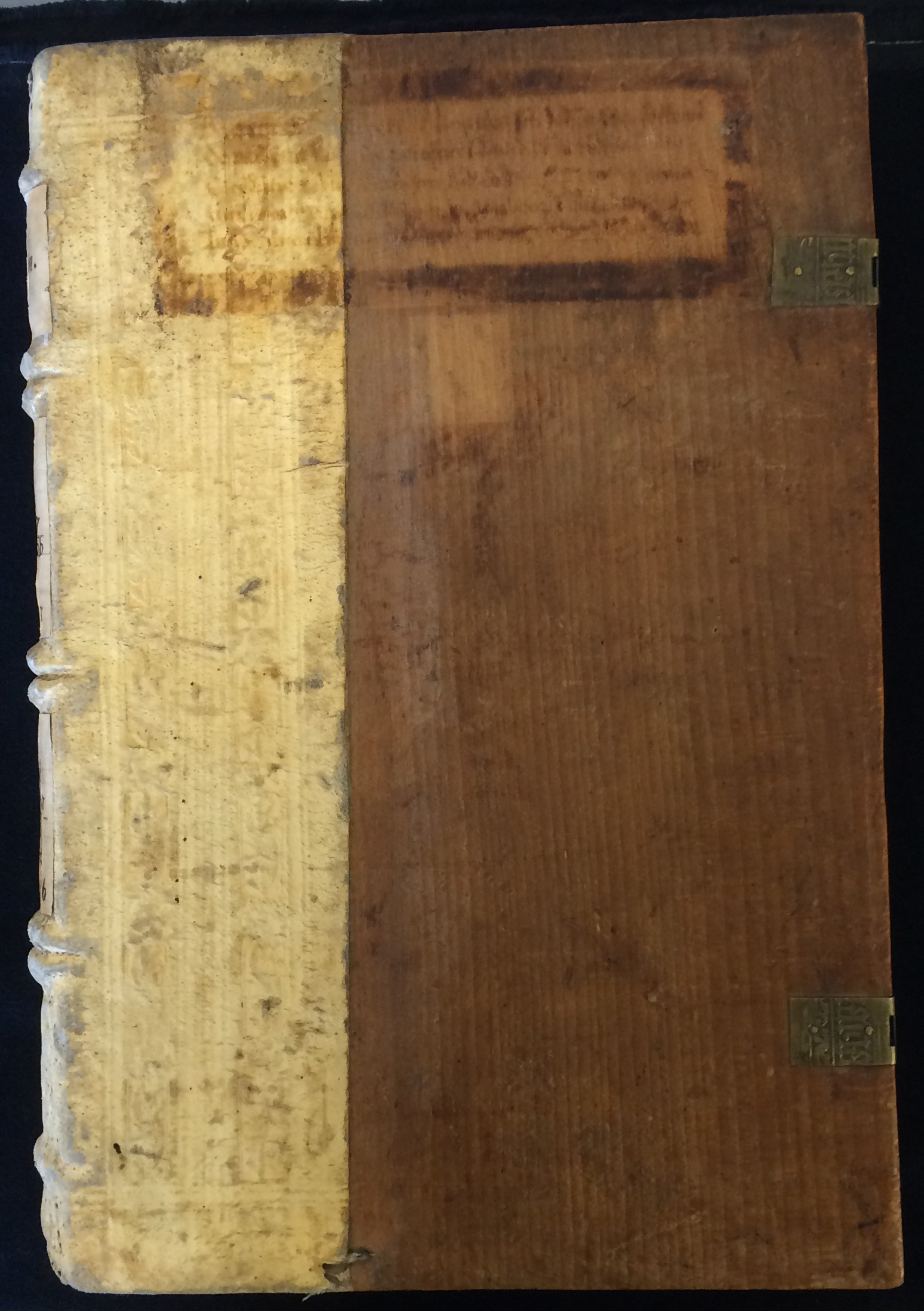'Sammelband' is a German term meaning 'anthology', which, in a general sense, bibliographers often employ to describe a bound volume that contains a group of separately published works. Strictly speaking, a 'sammelband' originally defined medieval or Renaissance books that included a mixture of manuscript and printed tracts, such as religious and political pamphlets.
Our volume is bound in a fifteenth-century German binding: quarter bound alum-tawed, and blind-tooled, pigskin over beech boards. Paper labels with the titles of the treatises were added to the spine. In fact, they were added after the original paper label became detached from the front cover. One can still see the vestiges of the glue that was applied to the borders of the missing label, whose ink has left written marks on the wooden cover.

Fifteenth-century German binding: quarter bound alum-tawed, and blind-tooled, pigskin over beech boards
Here is the imprint information describing the works contained in this volume:
-Martinus Polonus. Margarita decreti seu Tabula Martiana [Venice]: Peregrinus de Pasqualibus, Bononiensis [and Dionysius Bertochus, about 1485].
-Johannes Chrysostomus. Sermones de patientia in Job. Ed and tr: Lilius Tifernas (Castellanus). Add. De poenitentia in David; De virginitate. Cologne: Johann Koelhoff, the Elder, 13 May 1487.
-Johannes Johannis. Concordiae Bibliae et Canonum cum Titulis Decretalium Totiusque Iuriscivilis. Basel: Nicolaus Kesler, 22 June 1487; 12 July 1487.
-Johannes Koelner de Vanckel. Usus feudorum [Cologne: Johann koelhoff, the Elder, after 21 Feb. 1486].
In brief, we have various religious and legal works, including bible concordances, sermons, and a work on feudalism. As I will argue, this compilation was expressively designed to be read by monks and nuns.

Front paste-down paper with handwritten inscriptions, bookplate, and catalog-entry numbers : H: Ludwig Hain's Repertorium bibliographicum (1822); HC: W.A. Copinger's Supplement to Hain's Repertorium Bibliogaphicum. Part I (1895)
See the following two Latin inscriptions written by different hands and at different times:
(E)x p(at)ri(bu)s liber attinet d(omi)no/ Bartholomeo Hagen/
Sed nu(n)c spectat ad bibliotheca(m) fr(atru)m mi(n)or(um) apud mo(n)iales/ Brixine (com)mora(n)tiu(m) ex testame(n)to d(omi)ni Frederici Prenner quo(n)da(m) capellarii S(an)cte Catherine in Runcada collatu(s) a d(omi)no Johanne Schaner/ eius testame(n)tario anno domini millesi(m)o qui(n)ge(n)tesimo vicesi(m)o secu(n)do die octobris 15
The English translation is as follows:
This book from the fathers belongs to Bartholomeus Hagen.
But now it belongs to the library of the Franciscan brothers who stay in the convents of Brixen, as stipulated in the will of Fredericus Prenner, who was once chaplain of Saint Catherine in Runcada, the book being brought by Johann Shaner, his executor, on 15 October 1522.
Thus, our copy had two individual owners, Hagen and Prenner, before ending in the library of one of the convents of the Diocese of Brixen (Northern Tyrol, Austria). Additionally, the bookplate is the ultimate testimony about how our library could purchase this book. Born on December 3, 1907 at Fort Hannock, New Jersey, Stephen Tucker Spaulding was the only son of Major Thomas M. Spaulding, "02. Stephen enrolled as a LSA student at the University of Michigan in 1924. He was an excellent student and athlete, being part of the football and swimming teams. As a result of a leg injury playing football, Stephen would develop bone cancer, dying in Ann Arbor on November 25, 1925. Shortly after his death, his parents established a book fund in his memory, whose income was originally intended for the acquisition of books in the field of early English history. Books purchased on this fund are marked by a special bookplate designed by W.H.W. Bicknell of Winchester, Mass., who had built his reputation working for the Bibliophile Society of Boston. [1]
![Hand-written inscription on the first page of Martinus Polonus's Margarita decreti seu Tabula Martiana [Venice]: Peregrinus de Pasqualibus, Bononiensis [and Dionysius Bertochus, about 1485].](/sites/default/files/blogs/readingroom/firstpage.jpg)
Handwritten inscription on first page of Martinus Polonus. Margarita decreti seu Tabula Martiana [Venice]: Peregrinus de Pasqualibus, Bononiensis [and Dionysius Bertochus, about 1485]
And on the recto of the first page we read a later provenance note:
Ex Bibliotheca F(ranciscorum) F(ratum) Min(orum) Reform(atorum) apud Clarisas. Brixinae 1646.
From the library of the Reformed Franciscan friars, in the convent of the Clarisas. Brixen 1646.
And if you ever wondered where the tab system as displayed on your computer screen originally came from, look at the paper tabs attached to the text block of our book: an excellent instance of fifteenth-century tabbing!
[1] The Michigan Alumnus. 35, August 1927, 804.